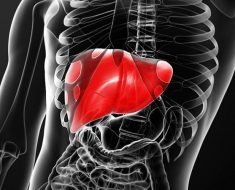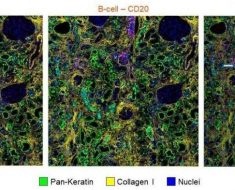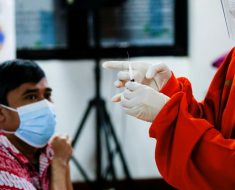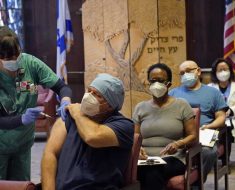
After more than a year of anxious waiting, women newly vaccinated against COVID-19 are flocking back to mammography clinics to catch up on routine tests that were delayed by the pandemic. In some cases, they’re met with one more pandemic surprise: a false red flag for breast cancer.
Like a sore arm or slight fever, lymph nodes enlarged by the immune system’s response to a COVID-19 vaccine are virtually always a sign that the shot vaccine is doing its job. But to the medical specialists who scour mammograms for signs of malignancy, the unexplained appearance of swollen lymph nodes has typically sparked concern and a recommendation that the patient be called back for further testing.
The result has been new uncertainties for women and the doctors who care for them.
If it’s a false alarm, women certainly don’t need the worry-inducing call reporting an “abnormal reading” on their mammogram. And few welcome the additional tests that tend to follow.
But as much as doctors wish to spare their patients unnecessary angst, they also want to avoid missing a signal that could be important.
“It’s a bit of a balancing act,” said Dr. Lisa Mullen, a breast imaging specialist at Johns Hopkins University School of Medicine in Baltimore. With many basic questions about the rash of enlarged lymph nodes still unanswered, the world of breast cancer screening has been forced to call some audibles.
The radiologists who scour mammograms for signs of cancer are not easily rattled. They examine thousands of breast images each week and make lots of judgment calls.
It’s not very often they are downright flummoxed.
On a typical pre-pandemic day, Dr. Hannah Milch at UCLA Medical Center might have seen one screening mammogram ambiguous enough to recommend further testing. And those cases rarely involved swollen lymph nodes in a woman without a notable risk for breast cancer.
In fact, radiologists say those “axillary” lymph nodes are usually elusive. Studies have shown that no more than .04% of mammograms reveal enlarged lymph nodes in women with no other sign of illness or malignancy. Tucked into the armpit, they are more likely to recede from a mammogram image than to photobomb it.
But after COVID-19 vaccines began to roll out, and healthcare workers and older women (the ones at greatest risk of breast cancer) began to pour in for mammograms, Milch started recommending callbacks five to seven times per day. In most cases, they were for “adenopathy”—lymph nodes that seemed unusually enlarged.
Milch’s colleagues reading mammograms across the country were seeing the same thing.
“I thought, “What is going on here?'” she said. “It definitely stimulated conversation.”
An unheralded piece of human anatomy, the body’s lymphatic system plays a key role in collecting and removing cellular debris from the body. Like rubbish bins set out along well-traveled corridors, the lymph nodes will bulge noticeably if some unusual process is generating more trash than usual.
When the body is fighting an infection—or thinks it is, after a dose of vaccine—the immune system dispatches an army of cells and proteins to mount a defense, leaving a lot of detritus in its wake.
Cancer, too, mobilizes a lot of cellular machinery. It uses the lymphatic system to travel to distant sites and leaves behind a telltale mess.
Close to both the breast and whichever arm gets a jab of vaccine, the 10 to 20 lymph nodes inside each armpit can act as a sentinel when radiologists see signs that they are swollen. But whether a node is enlarged due to infection, vaccine, trauma or cancer is not always clear.
To gain clarity on that life-or-death question, a woman is usually called back for an ultrasound or a biopsy, in which tissue is removed from the breast for further testing.
Getting that call “strikes fear in the heart” of the woman who gets it, said Dr. Philip M. Bretsky, a Santa Monica primary care doctor. “It’s like getting an abnormal pap smear: You hear it, and then everything else goes blank.”
With COVID-19 vaccine now widely available and coronavirus cases declining, Bretsky has been urging his patients to get current on their breast cancer screenings. But he’s made a point of warning them that if they do get a callback after a mammogram, the culprit is far more likely to be a recent immunization than cancer.
Radiologists have long known that a recent dose of vaccine for shingles, tetanus or flu can cause lymph nodes to appear slightly swollen. But the sudden appearance of so many swollen lymph nodes, in so many women, came as a shock. In many cases, so was the size of the swelling.
“They seemed to be more prominent,” said Dr. Constance Lehman, chief of breast imaging at Massachusetts General Hospital in Boston. “We had seen mildly enlarged nodes with prior vaccinations but not to this degree.”
They also tended to be much bigger in one armpit than in the other. In one woman, the swelling would be seen only in the left axilla. In another, it would be all in her right.
“It was the craziest thing,” Lehman said. “Everybody said, “What’s this?'”
Dr. Devon Quasha has been on both sides of the emerging discussion. A primary care physician at Massachusetts General, she got a jab of Moderna’s COVID-19 vaccine in her left arm in early January. Ten days later, she had a medical workup to investigate pain in her breasts she had noticed while nursing her daughter.
Her mammogram revealed some very enlarged lymph nodes in her left breast. They were hard to miss and potentially worrisome. Her colleagues in radiology furrowed their brows and asked her more questions. When she recalled when she’d gotten the COVID-19 vaccine, and in which arm, they offered reassurances and suggested a follow-up after a few weeks.
Quasha became her hospital’s first case of what she called “post-COVID vaccine adenopathy.” Even so, she urges her own patients to get vaccinated and to get their mammograms as soon as they’re due. But, she tells them, “Be forewarned that if you’ve had your vaccine recently, there might be some findings that we’re coming to understand are likely benign.”
Enlarged lymph nodes were showing up in scans of other parts of the body too, Lehman said. Doctors in radiology practices everywhere were finding the swollen nodes in imaging studies of the heads, necks and pelvises of recently vaccinated people.
By late February, articles in specialty journals began to detail what radiologists were seeing. And by mid-spring, expert panels had been convened by the Radiological Society of North America and the Society of Breast Imaging.
Women should be asked if they’ve been vaccinated against COVID-19, how recently and in which arm they got their jab, the experts advised. If possible, women should plan a screening mammogram at least six weeks following her second dose of vaccine. Women who have had a previous breast cancer should get their shot in the opposite arm. (Enlarged axillary lymph nodes could probably be avoided by getting the shot of vaccine in the thigh instead of the upper arm, Lehman noted.)
And in the absence of other evidence pointing to the possibility of cancer, recently-vaccinated women with enlarged axillary lymph nodes should be called back at least six weeks later to give the lymph nodes time to recover.
Not all mammography practices have taken the recommendations to heart.
Some advise women without breast complaints to put four to six weeks between a dose of COVID-19 and a screening mammogram. Others, wary of discouraging women from getting either the vaccine or a mammogram, are urging women to come in as soon as they can.
While the members of both expert panels acted quickly to issue their recommendations, they acknowledged that the advice amounted to “expert opinion without data,” said Milch, who was among the authors of the Society of Breast Imaging recommendations.
The new guidance was largely based on anecdotal evidence generated in response to the Pfizer-BioNTech and Moderna vaccines. It’s not clear yet whether Johnson & Johnson’s single-dose vaccine will evoke the same response.
Nor is it clear how long it will take for the swelling in some women’s lymph nodes to abate or whether their reactions will be more pronounced after the second shot than after a first.
Radiologists wonder whether some configurations of swollen lymph nodes can be dismissed lightly, while others warn of something more ominous. And they wonder how women’s lymph nodes will respond to COVID-19 boost shots, if those prove necessary.
“There’s a lot that’s unknown,” Mullen said.
One message is clear: If a woman has felt a lump in her breast or is experiencing soreness in or around her breast or discharge from her nipple, she should get her symptoms assessed right away.
Here, too, radiologists are quick to point out that the enlarged nodes they are seeing do not amount to a link between the vaccine and breast cancer.
“I see no connection whatsoever,” Lehman said. “There is not one bit of evidence that would even suggest that.”
On the contrary, she said, “I like to think of this as a good thing: In response to vaccine, the immune system is doing the work it’s designed to do.”
After a year in which screening mammography declined by at least 20% from recent levels—and when there’s growing evidence that patients are being diagnosed with more advanced cancers as a result—women certainly should not skip their mammograms after getting the COVID-19 vaccine, doctors said. Nor should they skip the vaccine for the sake of a mammogram.
Source: Read Full Article





